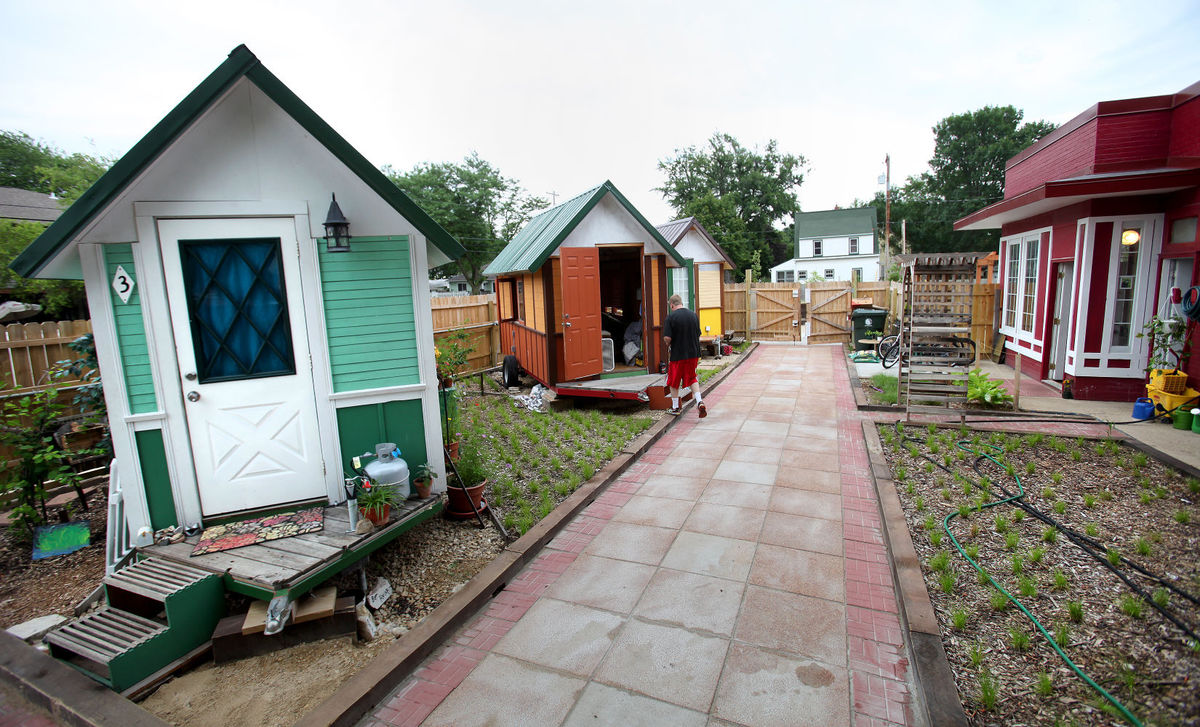<!– –>
<!– –>
<!– –>
<!– –>
<!– –>
<!– –>
By Jason Crider | December 20, 2017
<!– –>
When it comes to super-sized housing problems like affordability and energy efficiency, people across the nation and around the world are turning to a super-small solution: the “tiny house.”
The tiny-house movement centers around small, simple homes that cater to minimalist and eco-conscious lifestyles. Tiny houses are typically under 500 square feet, with “small house” counterparts under 1,000 square feet. They tend to have excellent energy efficiency and a low environmental impact, making them affordable alternatives to most contemporary American housing.
“Like most cities, Gainesville lacks affordable housing,” says Nichole Campbell, research scholar at the Shimberg Center for Housing Studies at the University of Florida. “Suburban housing that was created in the 50’s was built for families, and a lot of times now we’re living in smaller groups than we used to. Our housing needs are different than they once were, and our housing hasn’t changed.” Campbell specializes in design methods that optimize the social and environmental well-being of occupants. She sees a new generation of homeowners turning away from the sprawling energy-eaters their parents preferred.
Advocates say tiny homes also are among tools that could help break up the concentration of Gainesville’s low-income homes into a few neighborhoods where citizens are more likely to suffer the disparities found in the Energy Burden series: paying much more of their income for utilities; suffering disproportionate impacts from storms; putting up with substandard housing and unresponsive landlords; missing out on solar opportunities and other insults. Blending housing affordability throughout the city would fix some of those trouble spots.
However, while Gainesville might seem a natural fit to lead the tiny-house craze, with its student population and green reputation, it actually lags behind. Tiny house developers and investors face a number of local problems, from banks’ unwillingness to approve small enough loans to zoning challenges and insurmountable utilities hook-up costs.
Tiny house nation
Founded in the 1970s, the tiny-house movement picked up traction after the mid-2000s housing bubble and subsequent financial crisis by offering affordable housing solutions. Tiny houses have also popped up after hurricanes and other natural disasters.
While reality shows such as Tiny House Nation and Tiny House Hunters provide a certain pop-culture sensibility to the movement, tiny houses are here to stay. In 2010, Portland spurred an explosion of successful tiny-house communities across Oregon with trend-setting deregulations of accessory dwelling units. (ADUs, sometimes called “in-law suites,” are small, secondary dwellings on the same property as a primary home.) Madison, Wisconsin, has recently implemented tiny-house neighborhoods through the nonprofit “Occupy Madison” as a solution for the city’s homeless population. After Hurricane Katrina, designer Marianne Cusato developed the “Katrina Cottage” in response to the shortcomings of the Federal Emergency Management Agency trailers issued after natural disasters. And just a few hours south in Tampa, local NGO Tampa Bay Tiny Homes has inspired a surge in tiny-house communities, constructing model homes for $25,000 – $75,000.
In contrast, tiny houses have been slow to take off in Gainesville.

While the size and minimal nature of tiny houses might make them seem easy to build, they often face development challenges. In fact, developers interested in implementing large-scale tiny-house neighborhoods have left Gainesville for less restrictive Florida cities nearby.
“We talk to someplace or somebody probably every week trying to make this happen here,” says Mary Alford, principal at The Sustainable Design Group, who has dedicated much of her time and work to small houses. “And they’re successful. There are probably 30 or 40 small homes currently under construction in Tampa’s downtown right now.”
But in Gainesville’s historic districts, old, smaller homes stand bookmarked by small empty lots with no plans to build.According to Alford, the private sector faces costly, she argues unnecessary, hurdles for launching a tiny-house project, with little profit possible. She suggests an update of city building code and policies that would cut red tape and provide incentives for more-creative interior development and more-sustainable dwellings.
Financial barriers
Another barrier is that banks are reluctant to loan money for new homes on lots with relatively low property values. “You can buy a lot in many of these places for as little as $5,000,” says Alford. But because the lots are so cheap, banks may not be willing to lend the amount required for the house. “Other cities have solved this problem by the city subsidizing the difference between the cost of construction and the appraised value for the first few people that invest in building in a new neighborhood. Then there is an incentive for private investment to come and build.”
One recent tiny-house neighborhood project in Gainesville collapsed when confronted by the city’s roughly $6,000 per-house utility connection fee. “The size of the hook-up fee is not relative to the price or the size of the home,” says Helen Warren, a Gainesville city commissioner and local Realtor. “One of the conversations we need to have is to look at some kind of waiver to make it more cost effective for a developer to put in tiny houses and to meet that need in the community.”
This is just one example of the city’s current policies not keeping up with newly emergent housing needs.
Alford would like to see a neighborhood redevelopment code that includes energy and quality standards. The city depends on private industry to redevelop these areas, she says, but has failed to create incentives like those in Oregon, Madison and Tampa that help lower barriers to investment.
“What private industry is doing right now, they’re going in and buying up these properties that are substandard, and holding onto that property for some future investment when Gainesville needs it.”
This perpetuates a low tax base for the city and the cycle of inequity, she says, continuing a system with neighborhoods dominated by rental properties in such poor conditions tenants can’t afford their utility bills.
A matter of time
Mayor Lauren Poe is more optimistic that the tiny-house trend is just a matter of time. “We have a hundred-year legacy of Euclidean zoning practices. Everyone says ‘this is how you build a city,’ and to unwind that is just difficult,” he says. “But we do not have resistance. Our staff are creative, they’re willing to, and even desirous of, changing things to allow for more diverse uses. They certainly want to really get into the affordable housing element of it, [as well as] quality of life, quality of built environment, and things like that.
“I think we’re having that conversation in a very meaningful manner. It’s just that it’s not one pen stroke and one ordinance change and then—poof—you’ve solved it. Everything is so entangled, and you’ve got to pull on a lot of threads.”
One solution that excites Campbell is the “pocket neighborhood,” which consists of high-quality small or tiny houses that surround a private park. Whereas two small, empty lots in Gainesville could be used to build two standard houses, this same space could be easily retrofitted into a pocket neighborhood.
“I think it’s a matter of someone coming in and d
oing it successfully in a way that shows that it can be high-quality housing,” says Campbell. “It can be attractive, and all the things that people want, but it’s just a little smaller.”
And while a large-scale development of tiny homes may not be feasible at the moment in the city, steps are being made to build small homes within the county. Grace Marketplace Charity Support Foundation is teaming up with YouthBuild to construct three micro homes as a means of affordable housing for Gainesville’s homeless population, set to break ground in February.
Gainesville’s now-closed waitlist for public affordable housing has well over 2,000 people on it, and there’s a four-year waiting period. “There just isn’t any housing,” says Arthur Stockwell, chairperson of the Gainesville Housing Authority. “A big micro-housing project would be really, really good.” If the Grace/YouthBuild project is a success, Stockwell and others have plans for a 100-unit development project in Southeast Gainesville.
Homes are often seen as status symbols, or containers full of our stuff; the bigger, the better, and the more stuff we can have, the happier we will be. But Alford, Campbell and other tiny-house advocates suggest that Gainesville residents and the community would benefit by thinking about homes in terms of performance—about how well we can live in our homes, rather than how big we can build them.
<!– –>
 Special Report from WUFT News
Special Report from WUFT News